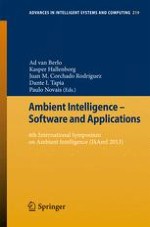Ambient Intelligence (AmI) is a recent paradigm emerging from Artificial Intelligence (AI), where computers are used as proactive tools assisting people with their day-to-day activities, making everyone’s life more comfortable.
Another main concern of AmI originates from the human computer interaction domain and focuses on offering ways to interact with systems in a more natural way by means user friendly interfaces. This field is evolving quickly as can be witnessed by the emerging natural language and gesture based types of interaction.
The inclusion of computational power and communication technologies in everyday objects is growing and their embedding into our environments should be as invisible as possible. In order for AmI to be successful, human interaction with computing power and embedded systems in the surroundings should be smooth and happen without people actually noticing it. The only awareness people should have arises from AmI: more safety, comfort and wellbeing, emerging in a natural and inherent way.
ISAmI is the International Symposium on Ambient Intelligence and aiming to bring together researchers from various disciplines that constitute the scientific field of Ambient Intelligence to present and discuss the latest results, new ideas, projects and lessons learned, namely in terms of software and applications, and aims to bring together researchers from various disciplines that are interested in all aspects of this area.
